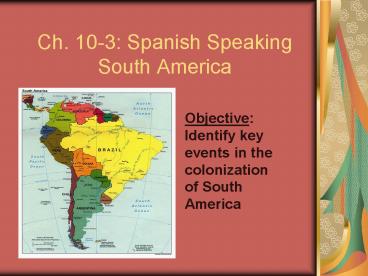Ch. 10-3: Spanish Speaking South America - PowerPoint PPT Presentation
1 / 24
Title:
Ch. 10-3: Spanish Speaking South America
Description:
Ch. 10-3: Spanish Speaking South America Objective: Identify key events in the colonization of South America The Inca and Pizarro In 1500s, the Incan civilization was ... – PowerPoint PPT presentation
Number of Views:731
Avg rating:3.0/5.0
Title: Ch. 10-3: Spanish Speaking South America
1
Ch. 10-3 Spanish Speaking South America
Objective Identify key events in the
colonization of South America
2
The Inca and Pizarro
- In 1500s, the Incan civilization was the major
power in Ecuador, Peru, Bolivia, Argentina, and
Chile. - Francisco Pizarro and his Spanish soldiers led an
invasion against the Inca and brought down the
empire.
Francisco Pizarro
3
Conquest and the End of Spanish Rule
- As a result of the Treaty of Tordesillas, control
of South America was divided between Spain and
Portugal.
4
The Inca
- The Incan Empire extended 2,500 miles from
Ecuador in the north to Argentina in the south. - The Inca built an extensive system of roads that
extended for over 20,000 miles through the
mountains and deserts of the empire
5
(No Transcript)
6
Spanish Conquest
- Pizarro and his soldiers were interested in
finding gold and silver. - They forced the natives to work in mines and on
farms. - The natives were horribly abused even though the
Spanish government and the Church passed laws
limiting the use of natives in hard labor.
7
The Effect of Spanish Conquest
- The Inca were forced to move from their villages
onto Spanish controlled plantations. - This disrupted their family structures and made
the area very difficult to manage.
8
Cultural Effects of Spanish Conquest
- The Spanish language was imposed on the natives
however, the Inca managed to retain their native
language called Quechua. - The Catholic religion was also imposed upon the
natives and is still practiced by the Inca today.
9
Independence Movements
- The American and French Revolutions inspired the
revolutions that swept through South America. - Simón Bolívar helped Colombia, Bolivia, Ecuador
and Venezuela gain their independence from Spain. - José San Martin helped to free Argentina, Chile,
and Peru from Spanish rule.
Simón Bolívar
José San Martin
10
(No Transcript)
11
Legacy of Conquest
- While revolutions brought independence, the young
countries began to fail as a result of geography. - The mountains created a formidable obstacle
making unification nearly impossible which led to
political instability and underdevelopment.
12
Economics
- South American economies are largely based on
agriculture, mining and limited oil. - Bolivia- tin, zinc, copper
- Peru- fishing
- Colombia and Venezuela- oil
- Argentina, Uruguay and Paraguay -agricultural
crops - Ecuador-coffee
13
Chile- Economic Success
- Chile is an economic success story because it has
developed international trade relationships with
the U.S. and Asia. - Chile has been the leader in working for economic
cooperation among South American nations where it
is an associate member of Mercosur.
14
Mercosur
- Mercosur is an economic free market that began
cooperation in southern part of South America in
1995. Goals - Make member economies more stable
- Increase trade within the region and decrease
dependency on unstable global markets - Channel some of the profits of improving
economies to those people and groups that most
need help.
15
Literacy and Education
- South American countries have a higher literacy
rate than Mexico, Central America or Caribbean
countries at about 90. - Chiles literacy rate is 95
- Education is very important throughout South
America but particularly in Chile.
16
Ch. 10-4 Brazil
- Brazil was Portugals largest colony.
- The Portuguese were interested in finding gold
and silver but did not find any. - Sugar plantations took the place of gold mines
and became the most important export from Brazil
17
Settlement in Brazil
- Settlement along the eastern coast was easier
than in the interior because of the rainforest. - The Native populations died off as a result of
European diseases and African were brought in to
work in the sugar cane fields.
18
Slavery In Brazil
- As a result of the introduction of Africans, the
Brazilian population is a mix of European,
African and native ancestry.
19
Independence for Brazil
- Brazil remained a colony of Portugal until 1822.
This revolution came about as thousands
Brazilians signed petitions asking for
independence. - Dom Pedro, the Portuguese kings son, agreed to
rule Brazil as an independent nation.
20
National Culture of Brazil
- Brazil is an immigrant nation with large numbers
of people from Europe, Asia, and the Middle East. - Catholicism is practiced however, among some of
African descent, it is combined with African
religious rituals.
21
Brazil- An Economic Giant
- Brazil is a growing economic power because of
its natural resources, hydroelectric power
generated by its many rivers, large oil reserves
and natural gas.
22
Carnival- Rio de Janeiro
23
The Darker Side of City Life
- Drug abuse
- Poverty
- Crime
- Slums
24
The End































